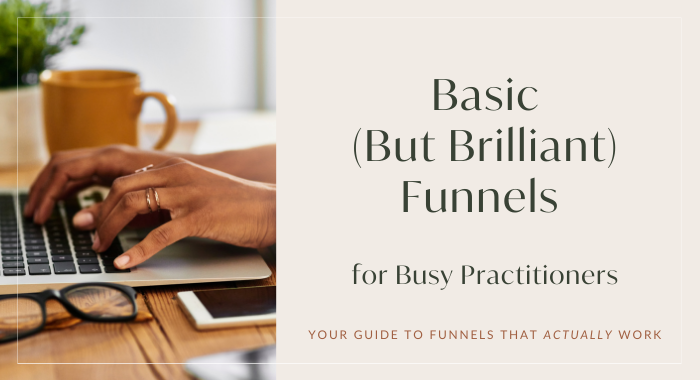Ready for Step 4 of the Money Mindset series? So far in this series, we’ve talked about getting properly set up as a business, whipping our mindset into shape, and pricing for practitioners. With all that in place, it’s time to talk about the bottom line – making a profit.
Making Profit As A Practitioner
Whether your business is offline or online, profitability is required if you want to stay in business.
When I first started my practice, I didn’t understand that there are growth seasons, where you put so much money back into your business to grow, change, and shift it into what you want it to be.
And then there are profit seasons.
Growing Your Business
A growth season feels kind of like an elastic band that’s been stretched out as far as it will go and feels like it’s going to snap back in your face at any moment. And you wonder if you can even do this.
And then, what generally happens with business is it begins to make a profit.
Making A Profit
During the growth part, your resources and money get tighter because you’re investing it into your business. You’re not just spending it frivolously, you’re investing it so more money can come through your business and you are able to serve more people.
Which leads to more profit when your resources and money begin to build up. And that allows you to live the life you would like to live, enables for your flight plan, and helps you serve your clients in a better way.
Now, the thing about creating profit is you first have to plan for it.
We’re going to talk about that a little bit later. But right now, let’s start with some foundations.
Recommended Reading
When it comes to the strategic side of money, there are two books that I highly recommend:
- Profit First by Mike Michalowicz
- Barefoot Investor by Scott Pape
These are both fantastic books.
If you have no experience with money like I did when I started my first business, these books are amazing to help you understand the ways in which we can actually provide a service and provide for ourselves at the same time. Rather than relying on a job to look after us.
From a money mindset perspective, some books I love are:
- Think And Grow Rich by Napoleon Hill (a very old book but stands the test of time)
- The Four Hour Work Week by Tim Ferriss (a game-changer if you are working or considering working online)
Why Profit Is Important
When you are in business, you need to pay attention to profit. And then, once you’ve generated some profit, you get to decide what to do with it.
Will you reinvest it into your business (growth season) or acquire it as profit (profit season) which allows you to move with opportunities when they come up?
But first – you have to start making a profit! And the first step is to look at your business to see what is most profitable and what is least profitable.
After working with hundreds of practitioners over the years, I have foundthat one-on-one consultations have a profit ceiling. There is only so much you can do in a one-hour time block when you are only with someone for that hour for a certain amount of money. There is no movement for that unless you put your prices up.
Whereas, when you create eCourses, memberships, programs, or packages – there are ways to build profit into these income streams.
And then you can utilize those profits for things like:
- extra clinical understanding
- going to a symposium
- investing in a dispensary
- or other improvements to your business or training
The first time I tried to save up money to go to a symposium, I was only working one-on-one with clients. The only reason I went that first year was because the clinic I worked at paid for half of my ticket. I couldn’t afford to pay for it myself.
The second year, I had left that clinic and started my own business and I couldn’t afford to go. It wasn’t until after I created eCourses and other things to enable me to get the profit I needed that I was able to invest in my CPE points, go on holidays, run retreats, and so on.
Identify Your Profitable Activities
The first step is to identify what is the most profitable in your business as well as what you can optimise for your clients.
How can you help them along a journey? Whether it’s via programs, packages, eCourses, or you working with them one-on-one on a consistent basis.
Identify what is most profitable in your business so you can focus on those activities.
Cash Flow
This is another area you need to pay attention to when it comes to money.
And when I say cash flow, what I mean is the direction that cash moves through the community you service – whether that’s a local area or global. You need to think about where that cash flow actually goes so you can be at the junction of where the cash is going and where your clients are.
Think of it like traffic.
If you wanted to catch a cab and there was a football game on, the quickest way to get a cab would be to go stand near the stadium where all the flow is going through. Whereas standing near the river on the outskirts of town where there is hardly any flow of traffic would make it much harder to hitch that ride.
The same happens with cash, especially in light of current events.
People do want to invest in their health. It’s a huge deal since this pandemic happened. People are considering how they look after themselves, what they invest in (particularly online), and how they’re going to change their life.
They want to get out of the position they were in prior to this – burnt out, not focusing on themselves or their families, not looking after their health.
So cash is going to these places already. The great thing about it is you can be there to help them.
Cash is also flowing into other areas such as memberships. People are starting to recognise the value of consistently being part of a community online.
Find Where Cash Currently Flows And Intersect With It
So, for example, consider how you might add a membership offering to your business.
Where in your tight ideal week could you put in the time for a membership?
Does a membership or package for your ideal client fit into your ideal business model?
Because if that’s where the money is currently flowing, where the customers are, then you want to join there.
Know Your Numbers
It’s important to understand something about being in business online – it’s all a numbers game.
So knowing your numbers is key.
Conversion Rates
Here’s one very important number you definitely need to know. Your conversion rate.
Your conversion rate tracks how many of the eyes that see your particular thing take action.
For instance:
- out of all the eyes that saw your latest offer, how many bought it? (1-3% is a typical conversion rate for sales)
- when you post on social media, how many of your audience members engage with it (comment, like, share)?
So, it’s a numbers game. You need to get enough people to see:
- how you do business
- the way you help people
- how you are involved in health
- the way you communicate around health and wellbeing
Whether they are on your email list, on your social media, or somewhere else – you need to get in front of enough of your ideal clients so that at least 1-3% of them will convert.
These are numbers you can find using Google Analytics on your website and from the analytics your various social media accounts provide.
So if you don’t already have those things setup, you need to. And if you do – start tracking those numbers monthly.
Take General Stats With A Grain Of Salt
Now, that “typical” 1-3% conversion rate statistic is based on general online data and stats.
What I have found – personally and with my mentees – is that we can often get around 10-30% conversion because we have a different relationship with our potential clients than other types of business. Because it’s all about health and wellbeing and involves sharing stories or information that directly affects them, they tend to take it more seriously.
How To Use Conversion Rates
Once you know what your usual conversion rate is – whether it’s 1% or 30% or anywhere in between – you can use that information to fill up your eCourses, memberships, and programs. Because it’s a numbers game.
For example, let’s say your conversion rate is 10%.
Knowing that, if you want to get 10 people signed up for your eCourse, you need 100 of your ideal clients to see your offering. So if you post on social media about that eCourse, your goal would be to have at least 100 people engage with the post (comments are the best). And your 10% conversion rate means that about 10 people from that group would end up buying your eCourse.
See how that works?
I know, the idea of getting 100 people to engage with your post might be a sobering thought. Just remember it’s a numbers game and work the numbers. Paying attention to your numbers – like conversion rates – can make a big difference in your business.
To get started with this, start tracking:
- how many people see your social media posts
- engagement rates for your social posts
- Google Analytics
Look, I get it. A lot of us are empaths and we love just hanging out and helping people, so the numbers are something we might leave behind.
But it’s a really important thing you need to pay attention to on a regular basis.
Create a Plan
So you might be thinking, this is all well and good. But how exactly do I do it?
First, you need to have a plan.
Start with a yearly plan for the amount of money you would like to make and the amount of profit from that you would like to make on a quarterly basis.
You need to track your profit and loss. How much goes in and out of your business, whether it’s a growth season or a profit season.
Make time to check your numbers on a monthly basis – particularly if you are a GST-based business.
And on a weekly basis, you need to keep track of what bills you have coming due and what income you expect to come in.
Where Your Attention Goes, Energy Flows
If you don’t pay attention to your money, if you don’t have a relationship with your money and it’s flow, then it’s likely to get out of flow.
When that happens, you might end up in a situation where you’re not sure what’s:
- making you money
- costing you money
- making a profit
- not making a profit
And that makes it hard to stay in business and help all the people you are genuinely here to help.
So, create a plan. Stick to the plan and see what happens.
Take Action
Consider what you can take action on right away after reading this article.
Are there things you need to stop doing?
What do you need to start doing?
Download my free Money Management Worksheet and get started today.









Leave A Comment